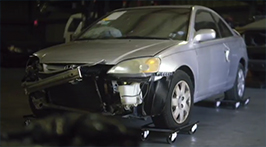Injection molding machines, also called injection presses or thermoplastic injection molding machines, are used in the manufacturing of molded plastic products. The machines work by heating plastic pellets into molten material, injecting the molten plastic into a mold, and then cooling the product.
Injection molding machines consist of two main elements: the injection unit and the clamping unit. The injection unit is where the plastic materials to be molded, commonly in the form of plastic pellets, are fed. The clamping unit is the main molding cavity where the plastic will be shaped. Optional elements on injection molding machines include robotic arms and conveyor belts.
The machines are frequently used in industrial settings for use by commercial or industrial workers. Workers may have to remove cooled plastic parts from the mold or operate the interface.
Defects of Injection-Molding Machines
Injection molding machines suffer from two main types of defects, some of which can lead to hydraulic pressure injuries. These defects are generally heating issues and hydraulic pressure issues.
If molds seal improperly, the injection unit becomes backed up, or there is improper venting on the machine, heating issues can result. Hydraulic defects can occur when there are contaminants in the hydraulic fluid or there is a loss of pressure in the system. Maintenance of the hydraulic system, including regular change outs and purification of the fluid, is important to prevent defective products and injuries.
Failures of Injection-Molding Machines
Specific product failures for injection molding machines center around malfunctions of the mold and the molding materials. Injection molding is a complex system, and the heat and movement of the material can cause a number of issues. Machine failure is typically predicted by an increase in faulty products. Molds that are blistered, ribbed, contaminated, or otherwise imperfect are a warning sign for potential product failure.
Injuries Caused By Injection-Molding Machines
There are many potential injuries that can occur with the use of injection molding machines. If hands or limbs are caught between the molding plates, crushing injuries requiring amputation can occur while the machine completes its automated process. Some injection machines can have missing or broken safety guards, which creates a potential hazard for the user. There are numerous moving parts, hot surfaces, and high voltage points within the machine that pose a risk for injury.
Injection injuries are caused when the plastic inside the molding machine or the hydraulic pressure system is propelled out from the machine. This can pierce the skin and underlying tissue, leaving workers with bits of plastic and hydraulic fluid embedded below the surface of the skin. Exposure to toxic materials is also a problem. Injection molding equipment uses industrial-grade plastics that may produce toxic fumes when heated, and the powering hydraulic systems also provide opportunity for leaks of fumes and liquids including formaldehyde, acetaldehyde, hydrocarbons, carbon monoxide, and volatile organic compounds. There have been some cases of pneumonia and Legionnaires’ disease reported to have been caused by the inhalation of water mist used during the plastic cooling process.
Burns are a common result of injection-molding and hydraulic power system failure. Overpressurization may occur, as injection-molding materials have coating properties that can cause severe burns. Hot hydraulic fluids also burn, although they may be easier to remove quickly versus plastic materials.
Flying particles and pieces from overpressurization or mold leaks cause some injuries. Heated materials are unpredictable, particularly if the injection molding machine cannot be shut down quickly.
Reports of Ventilation Injury
In April 1999, the National Institute for Occupational Safety and Health (NIOSH) received reports of poor ventilation and fumes from plastics used in the injection molding process in a facility in Minnesota. Employees of the factory reported headaches, dizziness, sore throat, skin rashes, chronic ear problems, and shortness of breath.
In December 1998, the Occupational Safety and Health Administration of the U.S. Department of Labor released a bulletin to warn of the increased risk of Legionnaires ’ disease, a potentially life-threatening form of pneumonia, that has been linked to exposure to water used to cool the metal molds during the manufacturing of plastic products. A Baltimore, Maryland facility reported five employees with confirmed cases of the disease at the time of the bulletin, with three others having pneumonia and one employee having died.
